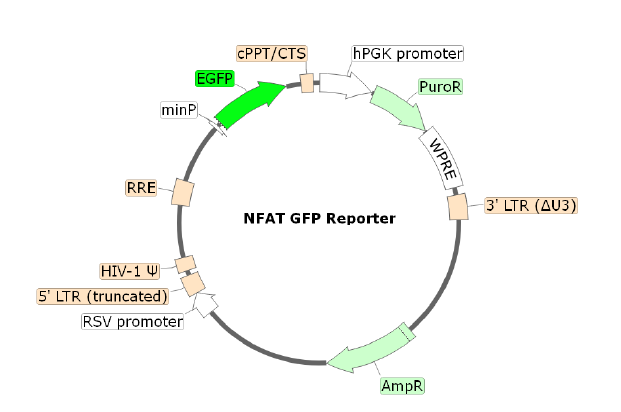NFAT eGFP Reporter Lentivirus
NFAT eGFP Reporter Lentivirus are replication incompetent, HIV-based, VSV-G pseudotyped lentiviral particles that are ready to transduce almost all types of mammalian cells, including primary and non-dividing cells. The particles contain an enhanced GFP (green fluorescent protein) reporter driven by the NFAT (Nuclear Factor of Activated T Cells) response element located upstream of the minimal TATA promoter. The lentiviruses also transduce a puromycin selection gene (Figure 1). After transduction, activation of the NFAT signaling pathway in target cells can be monitored by assessing eGFP expression.
Figure 1. Schematic of the lenti-vector used to generate the NFAT eGFP Reporter Lentivirus.
- Jurkat Cells (ATCC #TIB-152)
- Thaw Medium 2 (BPS Bioscience #60184)
- Lenti-Fuse™ Polybrene Viral Transduction Enhancer (BPS Bioscience #78939)
- Anti-CD3 Agonist Antibody (BPS Bioscience #71274)
- ONE-Step™ Luciferase Assay System (BPS Bioscience #60690)
- 96-well white clear-bottom assay plate (Corning #3610)
The lentiviruses were produced from HEK293T cells. Supplied in medium containing 90% DMEM + 10% FBS. Virus particles can be packaged in custom formulations and produced at higher titers by special request, for an additional fee.
The NFAT (Nuclear Factor of Activated T Cells) family of transcription factors plays an important role in mediating immune responses. T cell activation through the T cell synapse results in calcium influx, which is required to facilitate actin organization and interactions at the synapse. Increased intracellular calcium levels activate the calcium-sensitive phosphatase calcineurin, which rapidly dephosphorylates the serine-rich region (SRR) and SP-repeats in NFAT proteins. This results in a conformational change that exposes a nuclear localization signal (NLS), promoting NFAT nuclear translocation and inducing gene expression, including various cytokines (IL-2, IL-3, IL-4, and TNFα). Members of the NFAT family have been found in many tissue types, including the heart, skeletal muscle, and brain. These transcription factors are known to be highly involved in the pathological processes of inflammation and cancer. The use of eGFP (enhanced green fluorescent protein) allows for easy assay readouts.
Clipstone N.A., et al., 1992 Nature 357(6380): 695-697.
Lyakh L., et al., 1997 Mol Cell Biol. 17(5): 2475-2484.



